Industry’s Priority Areas Towards Achieving Vision 2030
By Phyllis Wakiaga,
The Manufacturing sector is among priority sectors identified by the Vision 2030, earmarked to catalyse Kenya’s leap to a higher middle income economy. As a key pillar, its notable contributions include 11 per cent share of Gross Domestic Product (GDP) in 2014, 40 per cent of merchandise exports and Ksh 141 billion in both employee compensation, and contributions to Government revenue.
Our vision to industrialize is attainable considering that the above statistics are derived from a sector that has stagnated for about 10 years. It is evident that newly industrialized economies, such as China, Malaysia and Botswana are also some of the fastest growing economies due to the expansion of their manufacturing base; hence their growth is registered to be approximately 7 per cent for three decades. These countries have indeed achieved higher middle income status. Additionally, they are quickly turning into high income economies with strong industry brands thriving beyond their borders. This is the growth that we aspire to as a country.
However, we have to recognise that the sector has had some difficulties times due to slow output growth, weak exports and the loss of flagship investors which does raise some questions. A good example, as I mentioned, is the stagnating contribution to the GDP – which means that as much as we are registering some growth in that area we are not growing as fast as we should in comparison especially to flourishing sectors like the service industry.
There is also unfair competition from subsidized imports from Asia and the rest of the World. According to the World bank, while Kenya’s growth is seen to be admirable, it has not been steady but rather volatile. It has also seen a much slower uptake of inclusive strategies which in turn has slowed down some pertinent economic aspects. The agriculture sector which is a complementary to the manufacturing sector has been faced with sluggish growth despite its contribution at 27 per cent share of GDP.
The development of the KITP provides a strategic vision to proactively address the challenges facing the sector and maps out low-hanging fruits that can be leveraged to kick-start our industrialization journey. Kenya Association of Manufacturers’ recently launched Manufacturing Priority Agenda complements the KITP’s vision in the efforts towards an industrial transformation.
The key challenges identified by KITP resonate well with the sector binding constraints that top the KAM advocacy agenda for this year. The government’s intent to grow our manufacturing base is a strategic one that can only be implemented through collaboration and knowledge transfer from industry.
The MPA looks at the progress made from last year’s agenda as well as the long-standing hindrances to achieving our vision. These issues are clustered into five pillars which are; developing a general policy framework, creating a level playing field, ensuring competitive local manufacturing, promoting export manufacturing and securing the future of industry.
When we talk of developing a general policy framework, we are looking at finding quick solutions for challenges presented in, for instance, the devolution framework.
We have the unsolved issues of levies and fees that are applied to businesses without adequate public participation at the county level with relevant stakeholders. As manufactured goods are transported across the country, they encounter numerous road-blocks and have to pay for advertising fees on entering each county. There are many ways that counties can collect revenues, but we must be careful not to stifle business expansion and trade across counties whilst implementing some of them.
A better regulatory environment should be achieved through more stakeholder consultations and impact assessments for proposed legislation to guard against impeding the sector. It would be interesting to see more recourse to Alternative Dispute Resolution mechanisms as a standard feature for regulatory bodies in dealing with business disputes arising out of taxation and heavy regulatory burden.
Under Macroeconomic predictability, we seek fiscal stability which is a prerequisite to achieving sustained long-term growth. Manufacturing can only thrive in an environment that encourages long-term planning. Is there a risk of higher taxation and higher borrowing costs to come? Manufacturers need to be made aware of any such risks so as to take them into account whilst scaling their businesses.
We would wish to see these constraints resolved through a rapid results strategy to gain lost time in Kenya’s industrialization process. I strongly believe that if the industrialization process is accelerated, a double digit growth for our economy would not seem so far out of reach.
The writer is the CEO of the Kenya Association of Manufacturers and can be reached on ceo@kam.co.ke.
Looking for elevation? KAM lifts you up.
- Direct technical assistance
- Capacity building programmes
- Networking and mentorship
- Industry insights & analysis
- Trade & export development services
